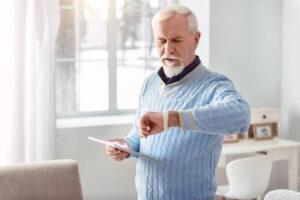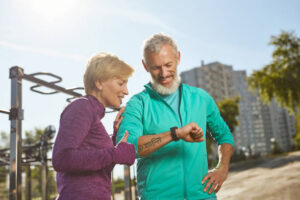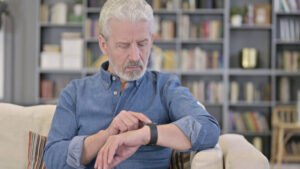As seniors age, they may require additional home care to help them with their daily tasks. However, providing home care can be a challenge, especially when family members cannot be present all the time. Fortunately, remote monitoring can provide a great solution for senior home care by allowing for remote monitoring of their health, safety, and well-being. Remote monitoring can provide peace of mind for both seniors and their families, as it allows caregivers to monitor their health and safety from any location, at any time. This technology can help to ensure that seniors receive the care they need, when they need it, and can provide early warning for any potential health issues. It can even help to reduce the risk of falls and other accidents, as well as providing real-time access to emergency services. With senior remote monitoring, family members and caregivers can have peace of mind, knowing that their loved one is safe and secure.

What is Remote Monitoring?
Remote monitoring is a type of technology that allows for remote monitoring of a person’s health, safety, and wellbeing. It is commonly used in senior home care as it allows for caregivers to keep an eye on their loved one from any location, at any time. Remote monitoring systems usually consist of a number of devices, such as sensors, cameras, and alarms, which are connected to a central monitoring station. This station can then be accessed remotely to monitor activity, detect any changes in health, and provide real-time access to emergency services if needed.
The devices used for remote monitoring can vary depending on the needs of the individual. For example, some devices may be used to monitor vital signs and detect any changes in health. Other devices may be used to monitor activity, such as movement, or to detect any falls or accidents. Additionally, there are devices available which allow for two-way communication, allowing family members and caregivers to stay connected with their loved one.
The benefits of remote monitoring are numerous. It can provide peace of mind for both seniors and their families, as it allows caregivers to keep an eye on their loved one from any location, at any time. It can also provide early warning for any potential health issues, as well as providing real-time access to emergency services. Additionally, it can help to reduce the risk of falls and other accidents, as it can be used to monitor activity and detect changes in health.
Benefits of Remote Monitoring for Senior Home Care
Remote monitoring can provide a range of benefits for senior home care. It can provide peace of mind for both seniors and their families, as it allows caregivers to monitor their health and safety from any location, at any time. Additionally, it can provide early warning for any potential health issues, as well as providing real-time access to emergency services. It can also help to reduce the risk of falls and other accidents, as it can be used to monitor activity and detect changes in health.
The use of remote monitoring can also help to reduce the burden on family members and caregivers, as they can be assured that their loved one is safe and secure at all times. This can be especially beneficial for those who are unable to provide full-time care, as they can still be informed of any changes in health or activity. Additionally, it can help to reduce stress levels, as family members and caregivers can be informed of any potential health issues before they become serious.
Finally, remote monitoring can provide a sense of independence for seniors, as they can maintain their autonomy while still receiving the care they need. This can be especially beneficial for those who are unable to leave their home, as they can still receive the care they need without having to leave the comfort of their home.

How to Implement Remote Monitoring
Once the right remote monitoring device has been chosen, it is important to ensure that it is properly implemented. First, it is important to install the device in the most suitable location. This may depend on the type of device, as some may require a specific location in order to function properly.
Once the device has been installed, it is important to ensure that it is properly maintained. This may involve regularly checking the device for any damage or wear and tear, as well as regularly testing it to ensure that it is working correctly. Additionally, it is important to ensure that the device is connected to a reliable power source, as some devices may not function properly without a constant power supply.
Finally, it is important to ensure that the device is properly monitored. This may involve regularly checking the device for any changes in activity or health, as well as ensuring that any changes are reported to the appropriate people. Additionally, it is important to ensure that emergency services are contacted if needed, as remote monitoring can provide real-time access to emergency services if needed.
The Benefits of Continuous Monitoring
One of the key benefits of remote monitoring is the ability to provide continuous monitoring. This can be especially beneficial for seniors, as it can provide early warning for any potential health issues. Additionally, it can help to reduce the risk of falls and other accidents, as it can be used to monitor activity and detect changes in health.
Continuous monitoring can also help to reduce the burden on family members and caregivers, as they can be assured that their loved one is safe and secure at all times. This can be especially beneficial for those who are unable to provide full-time care, as they can still be informed of any changes in health or activity. Finally, continuous monitoring can provide a sense of independence for seniors, as they can maintain their autonomy while still receiving the care they need.

Conclusion
Senior Remote monitoring can provide a great solution for senior home care by allowing for remote monitoring of their health, safety, and wellbeing. It can provide peace of mind for both seniors and their families, as it allows caregivers to monitor their health and safety from any location, at any time. Additionally, it can provide early warning for any potential health issues, as well as providing real-time access to emergency services. It can also help to reduce the risk of falls and other accidents, as it can be used to monitor activity and detect changes in health. Finally, it can help to reduce the burden on family members and caregivers, as well as providing a sense of independence for seniors. With remote monitoring, family members and caregivers can have peace of mind, knowing that their loved one is safe and secure.
